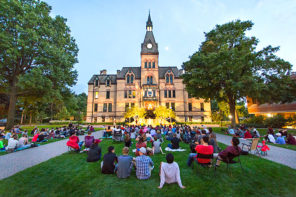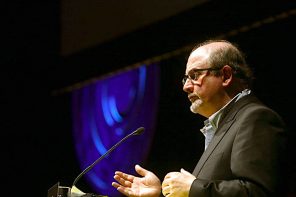Filed away in my office is a now-brittle and yellowed New York Times clipping from 1993 by the architecture critic Herbert Muschamp, who wrote:
Exploding buildings are [the contemporary global] community’s landmarks—its inverted arches of triumph, its sinister Taj Mahals. They provide images of a collective experience that is otherwise elusive. Traditionally, we look to buildings to provide symbols of social cohesion. Exploding buildings now perform an equivalent symbolic role.
The essay, published shortly after the 1993 World Trade Center bombing, reflects many then-current (but also prescient) ideas about how we relate to postmodern, post-industrial, post-Cold War secular life; and the symbolic possibilities for grief and community within this new world order.
I want to pick up on Muschamp’s insights about “images of a collective experience,” their “otherwise elusive” nature, and how this provides “social cohesion” (terms that relate closely to sociological definitions of religion) in order to think through the visual religious implications of 9/11.
With some trepidation, I am going to agree with British bad-boy artist Damien Hirst who asserted that the collapse of the trade towers was “visually stunning.” I think we have to admit this at some level; it was the nature of the moving-picture symbol that was so gripping, widely reproduced in mass media. It was awesome as it was awful; we were intrigued and devastated at the same time.
Religious traditions have worked with images of death for millennia, and it is ultimately a religious response (secular as it may seem) that emerges in these cases, which does not mean that “God” has anything to do with any of it. There is something profoundly human, which is to say deeply religious, about images surrounding death and about the ability to see death and dying.
And yet, we’ve got to get beyond the so-called “civilized” response that looking at death is simply voyeuristic and morbid. Instead, there is something crucial to our lives that necessitates reflections on death, and sometimes this means looking—slowly, carefully, deliberately, even contemplatively—at what we are most afraid of.
Before 9/11: Remembering our Visual Cultures of Death
Barbie Zelizer has investigated issues surrounding journalistic images of death better than anyone in recent years. From her books on photography and the Holocaust, to the JFK assassination, and on to 9/11, Zelizer has continually demonstrated the ways images affect a collective consciousness.
Remembering to Forget, for example, shows how photography became the medium of collective memory for the events of the Holocaust in the 1940s: images of Nazi concentration camps affected people across the world, as powerful photos surpassed the written word. Zelizer uses a 1945 issue of Life magazine as one demonstration, in which the editors offered an apologia to accompany a five-page spread of images of what the editors simply and over-generally titled, “Atrocities,” by saying:
Last week Americans could no longer doubt stories of Nazi cruelty. For the first time there was irrefutable evidence as the advancing Allied armies captured camps. With the armies in Germany were four Life photographers whose pictures are presented on these pages. The things they show are horrible. They are printed for the reason stated seven years ago when, in publishing early pictures of war’s death and destruction in Spain and China, Life stated, “Dead men have indeed died in vain if live men refuse to look at them.”
This last line is crucial, and applies as well to today’s wars as it did to the conflicts of a half century ago.
By the 1960s, it was film that brought us images of death. Abraham Zapruder’s visual documentation of John F. Kennedy’s assassination creates one type of image: a single movie camera records a death in motion, allowing this death to be replayed over and over. The 1963 event parallels the rise of the movies as a prominent form of “entertainment” within contemporary culture, and images of real death become increasingly impossible to disentangle from fictional death.
Growing up in the 1970s, I remember the popular Faces of Death videos. Many, though not all, of these deathly scenes were staged, but it was their presumed reality that gave them cult status. Some images, once shown on national media, are now displaced to underground channels of distribution. They become “cult” images rather than mainstream, and Faces of Death continues to sell as a cult classic, even restored and set in HD.
Fake images and real images. Is this all sensationalism? Perhaps so. But we are missing something much deeper if we merely end there. Why do millions of people pay to see such images? What is it, at heart, that we are looking for? Why do we want to watch?
During: Visual Documentation of 9/11
September 11, 2011 becomes the date of the most documented tragedy in human history. And it is most documented because of the prevalence of the video camera: Zapruder’s 8mm Bell & Howell on steroids. As motion-picture-capturing media becomes more accessible, our culture’s collective visual memory changes, as do our relations to images of death.
To get at some of the effects of the motion picture and our collective visual connections to mass death, compare, for example, these images:

A close inspection should easily indicate which images were “live” on September 11, and which were staged, but it is movies such as Godzilla (top left, from 1998) and Armageddon (bottom right, from 1998) and many more, that have displayed similar New York City destruction, and made this collective vision of exploding buildings so much more forceful, but also confusing. As many news commentators suggested of the 9/11 events: “It’s just like a movie.”
At first, that Tuesday morning, the billions outside the NYC area simply watched. And watched and watched and watched… the planes striking the trade towers. With a society full of camcorders, the images are endless. But while on the first day (the 11th) we saw planes striking buildings, people running through the streets, and people jumping out of buildings, the more extreme images were gradually left out. There was a lot of complaint about showing people jumping out of windows, yet this stirred at least one excellent response to a particular jumper known as “Falling Man,” written about by Tom Junod in Esquire, and accompanied by photos taken by Richard Drew.
The editing/excising of images continued to the point when, one year later, television news showed the familiar images of planes approaching the trade towers—the image dissolving just before impact. At the time, Peter Jennings noted:
We’ve been, I hope you agree, judicious about showing coverage from that day all throughout the last year. Our bosses decided, we all think quite wisely, to show the actual collapse of the buildings only when it was absolutely necessary. And this perhaps is one of those occasions when we will show it…
We didn’t want to watch any more. Or did we? Or was the final impact still so strong that our afterimage easily filled in the missing parts, as when we look at a bright light then turn away and the illumination still fills our vision? Michael Moore ably utilized this visual afterimage in the opening to his Fahrenheit 9/11, a film that begins with a black screen and the now-familiar sounds of people on the streets of Manhattan with the sound of airplanes flying overhead.
I wonder if there wasn’t something to the claims of Life’s editors noted above regarding Holocaust images. And I wonder if we haven’t, contra-Jennings & co., become excessively “judicious” in the elimination of images of death from our society.
Voyeuristically, we can aim our web browsers at www.grim-reaper.org, which offers “one-stop shopping for the morbid mind.” Alongside videos of autopsies and embalming procedures, they sell a couple documentary videos on September 11—one of which donates proceeds to the “Twin Tower Fund,” set up my Mayor Giuliani. Another video offers images of “people jumping to their death.” But years before the Internet, in 1928, Tom Howard strapped a miniature camera to his ankle and photographed the electrocution of Ruth Synder. The photo was displayed the next day in the New York Daily News (January 14, 1928) with the headline “DEAD!” One million copies sold that day.
The problem is not the desire to look; that’s much more human than we are willing to acknowledge. The problem is instead the need to find an adequate framework within which to view the images. Right now, voyeurs are consigned to underground clubs, cult films, and obscure-though-popular websites because the dominant social voice says looking at death is sick, morbid.
After: Improvised Community
I wonder if we can move beyond a voyeuristic reception, and rethink such images within the framework of an improvised religious ritual. Part of the accusation against “voyeurism” is that it is individual-based, typically defined as a single person looking at some socially unacceptable event (for “sexual excitement” says the DSM, and I’m not going to delve into the relations of the sex and death drives here). In distinction, so many of the immediate, interreligious, seemingly-natural responses to 9/11 were to set up visual, material objects—images, flags, t-shirts, stuffed animals, written prayers—in an altar-like setting.
Because images can be both a bomb and balm, there is the possibility to take images of death, even including people jumping from windows, and frame them within a ritualized context. This would be to create a collective discourse in words and images, to bathe the images in a communal framework, moving them beyond their one-way voyeuristic engagement.
Tom Junod indicates that the horror of the “Falling Man” image is that it is perched between the public and private, between individual death and collective imagery. And Susan Sontag, in her remarkable little book Regarding the Pain of Others cast doubt over the reality of “collective memory.” Yet she does come back and suggest there is “collective instruction.” It is not enough to only remember the image, but to encounter the extended story surrounding it.
What might it mean for a synagogue, a church, a mosque, or a temple to set up a video screen in its sanctuary and play these images of death from September 11, and then turn around and respond to them? What reinvented rituals might result from a ritualized, contextualized, reception of these images? Such communal framing gets us beyond the questions of morbid voyeurism, because it eliminates the one-way dimension and places images within a social setting. It further allows us to reflect and come to terms with dying, thereby stirring the potential for a good death.
This is not far from the great religious traditions after all, for at the heart of Buddhism is the young Siddharta’s “Four Visions,” especially including the image of a dead man, which finally challenges him to renounce his life and take the more difficult path that leads toward enlightenment. Then, of course, there is the central image of Christianity: a dead prophet who has died an agonizing death. It is interesting how many times the image of a cross is highlighted in coverage of ground zero, usually a nicely cropped shot of the ruins of steel girders. Though in good Protestant fashion, this is a cross without a dead body.
What we want, I believe (and here I may betray my own religiosity) is to be connected, to show and display and connect with compassion. As Sontag says, “Let the atrocious images haunt us.” The Sufis, I suspect, are correct: there is a current of love that underlies all creation, and interconnection is the real truth of matter. Looking at images of 9/11 may be one reminder of this, of our collective fate, a postmodern memento mori.




